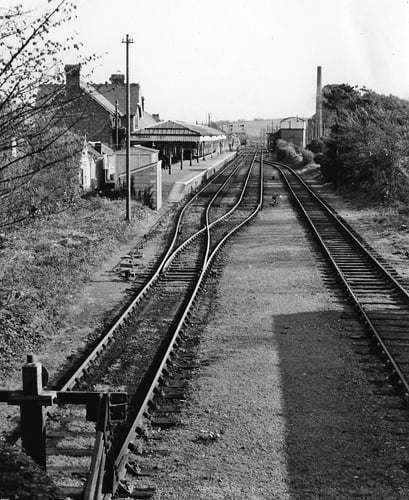VERY FEW clues remain of the fact Bude once had a railway station, which at its peak would see rafts of visitors venture to the North Cornwall coast for the summer holiday.
After all, pretty much nothing remains of the railway station, which is now a housing estate, save for a plaque on one of the houses and the naming of the road as ‘Bulleid Way’ – after the LSWR engineer Oliver Bulleid, best known for the Bulleid Pacific trains which served the town – unless, of course, you were proficient in local or railway history, it would pass you by as you visited the town centre.
While the memory of Bude station lives longer in those who were alive before it closed on October 3, 1966, and in a handful of photographs, the story of how Bude station came to be is something that only lives in the history books. However, given the effort taken by those who lived before us to get the railway to this part of North Cornwall, it almost seems slightly undignified that nothing remains of the thing they fought to create.
After all, the arrival of the London and South Western Railway (LSWR) to Bude was very much a case of ‘fourth time lucky’, for that was the number of acts of parliament it took for it to reach the town; while the railway station was eventually opened on August 11, 1898, as a branch line from Holsworthy, where it linked to the main LSWR line through to Halwill Junction, onto Exeter and eventually London Waterloo, plans to bring the railway revolution to Bude started as far back as January 1879.

The original vision was for a ‘smart coach’ service which would link Bude and Stratton with Holsworthy, where the first act of Parliament authorised the construction of the line to and it wasn’t intended at first, that the LSWR would venture further.
However, the residents of Bude and Stratton, wanting to be part of the railways, had different ideas and took matters into their own hand. By 1883, they had raised £1,000 towards the cost of promoting an Act of Parliament bill for a 9.5 mile extension to the railway line from Holsworthy which would follow a route that took in both towns and the adjacent village of Bridgerule.
A hand of money was enough to make the LSWR bite and they took up the offer of the locals, submitting the Holsworthy and Bude Railway Act to approve the construction of a railway line as the locals wished, and on August 20, 1883, the act was authorised by Parliament. Shortly after, a ceremonial cutting of the first sod took place and hopes were high that before long, Bude would be connected to the rest of the United Kingdom in a way it had never been before.
Sod cutting, however, was as far as it would go, for nothing happened after that date. No further building commenced on the extension and by October 1891, by which the deadline in the Act of Parliament would expire for its construction, it was looking extremely unlikely there would be a railway line at all. LSWR petitioned for an extension of a year to build the railways. This was granted, but by May 1892, no work had commenced, so the LSWR submitted a further bill to abandon the proposals altogether, with the ‘Holsworthy and Bude Railway Abandonment Act’ passed by Parliament on May 20, 1892.
The seeming abandonment of the plans to bring the railways to Bude, however, did not deter the residents of Bude and Stratton, who continued lobbying LSWR to promote a second bill to construct a railway line to their towns. This was successful, and a second act to authorise the construction of a railway link to the two towns was authorised on July 6, 1895, albeit on a different route to the one previously proposed.

At this point, the LSWR was investing heavily in the construction of the North Cornwall line, which would reach Padstow in 1899 and the company was keen to save money where possible.
The new, more direct route, reduced the project build costs of the railway line by £10,000 by avoiding the construction of a viaduct, however this posed a further problem; it would also avoid Stratton, which at the time was the more populous of the two towns. To appease the residents of Stratton, the new Bude railway station would be sited on the outskirts of Bude, with a short branch additionally laid to the Bude canal basin to tap into the commercial traffic in sand for construction.
At its outset, Bude railway station was a huge success. While passenger services were never particularly frequent, daily connections linked the town to London with through-coaches which were linked with other portions from services to Launceston and Wadebridge at Halwill Junction. The connection of the freight traffic from Bude canal for the construction sand and coal shipped in from Wales was also profitable, however, by the inter-war years of 1919 to 1939, the station’s decline had set in with the prevalence of road haulage and chemical fertilisers.
The station’s strength remained in its summer traffic, which saw whole trains to the town directly from London Waterloo, and the town was also connected with the famous Atlantic Coast Express, a through train from Waterloo, which after leaving London at 10:35, would run non-stop from Exeter St Davids to Halwill, before calling at Holsworthy and Bude, arriving at its final destination at 15:25.
By the 1960s, the increasing rationalisation and reduction of service by British Railways had meant that Bude first saw a reduction in services and the loss of its engine shed. The through-coaches to London Waterloo became defunct after the operation of the railway line was handed to the Western Region of British Railways from January 1, 1963, two months before the Beeching report would recommend the extermination of North Cornwall’s railways. The links to London ceased completely in the summer of 1965, when the London services were diverted to London Paddington and services to Bude instead reversed at Exeter St David’s.
The death knell of Bude railway station came in October 1966, with railway services to and from the town permanently discontinued by the Government. Within a few years, nothing would remain for the station as it instead became housing.
As for its replacement, the aforementioned Bulleid Way? The name was a nod to the town’s past, with Bude railway station becoming the last place you were able to see the famous Bulleid Pacific trains, which served the town as late as 1962, long after they’d disappeared elsewhere.





Comments
This article has no comments yet. Be the first to leave a comment.